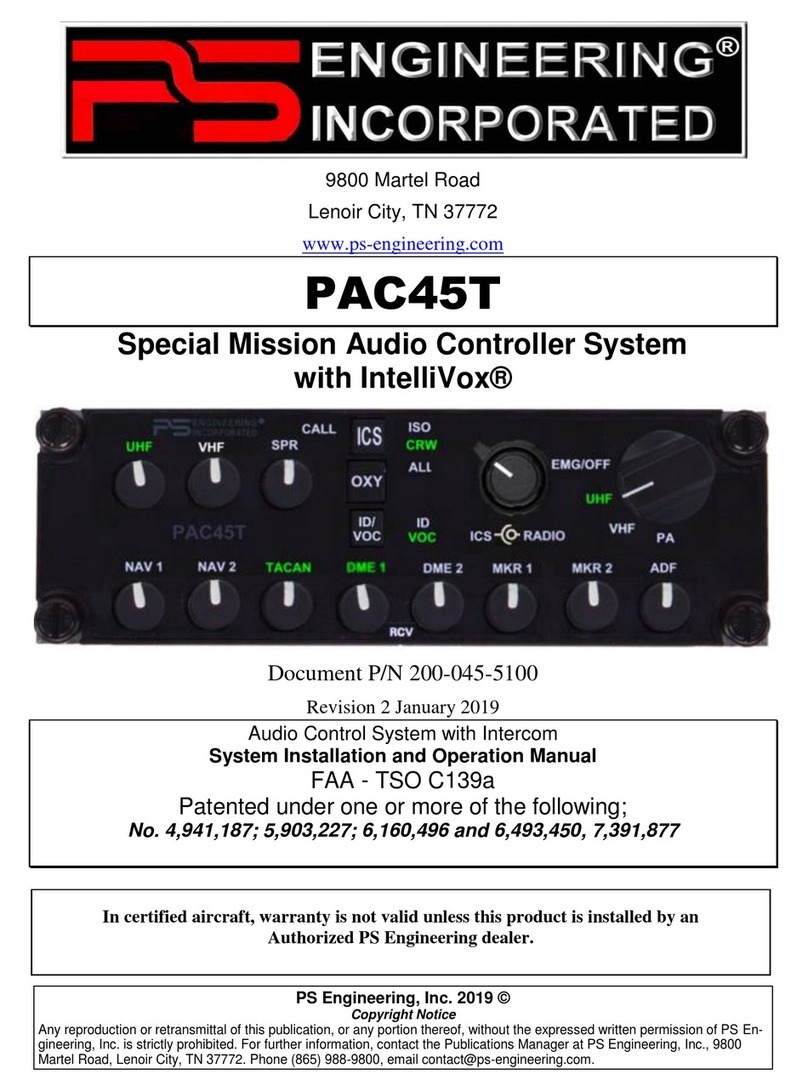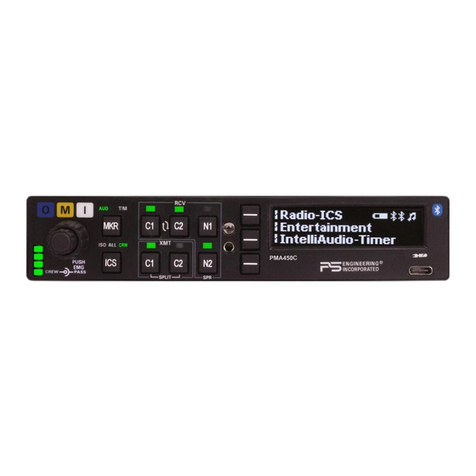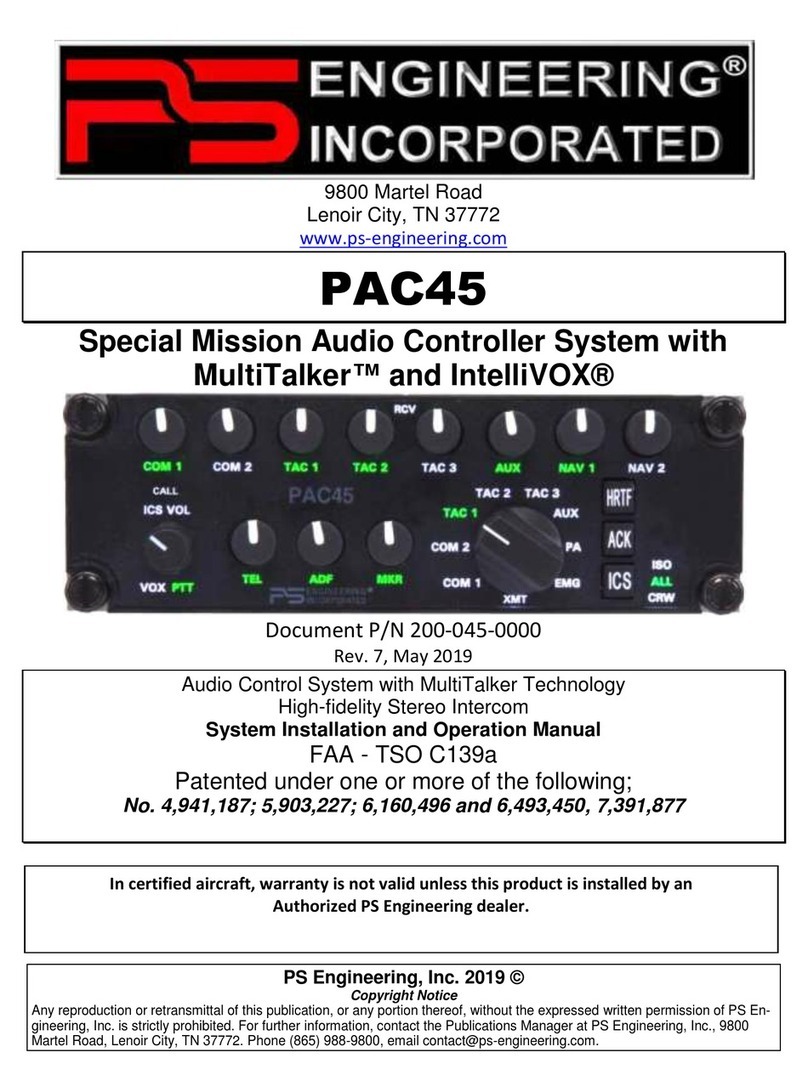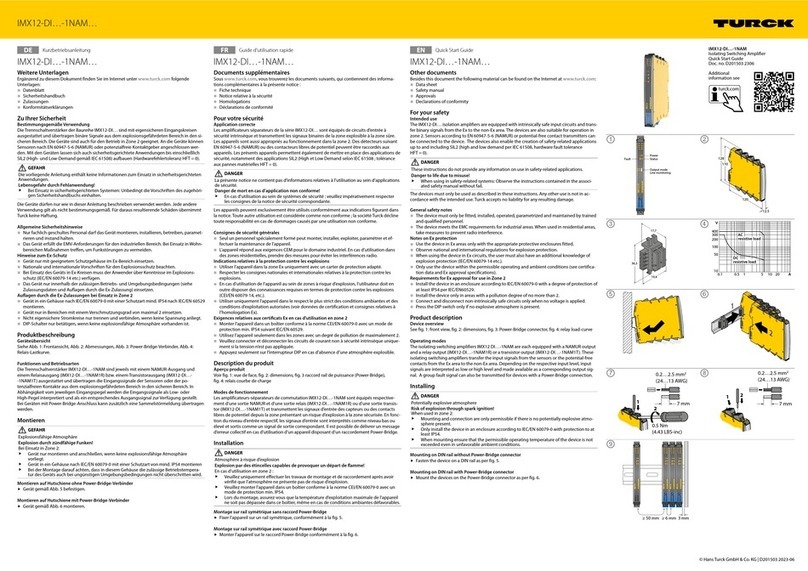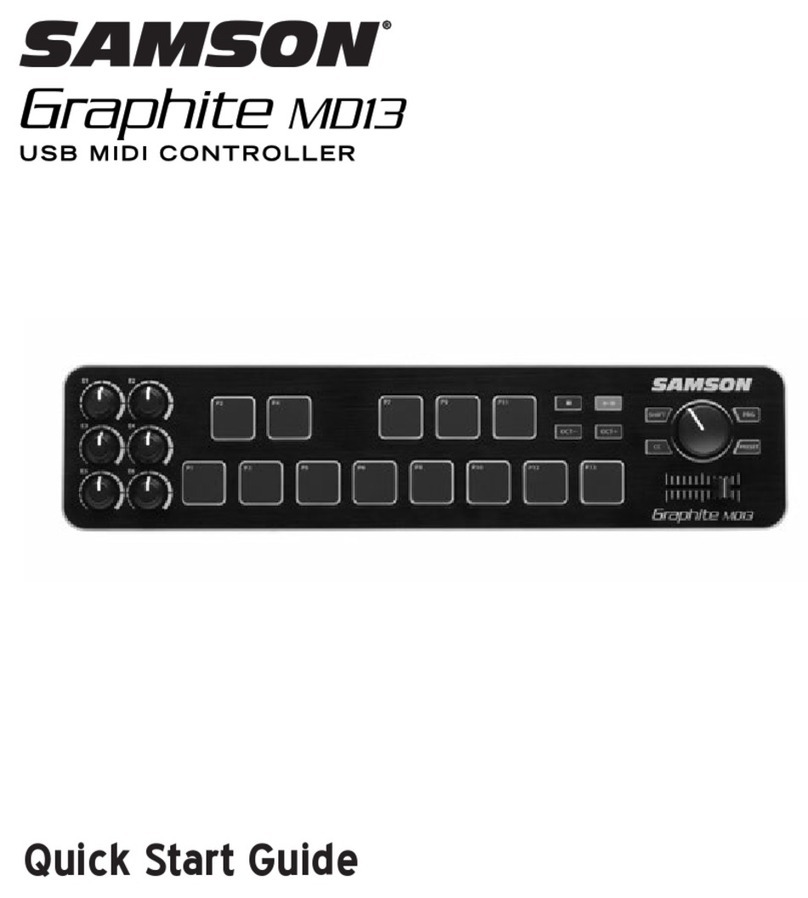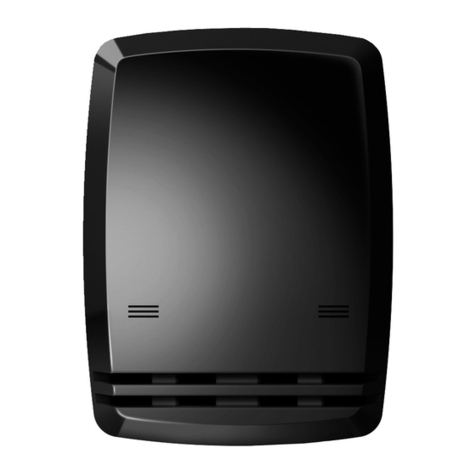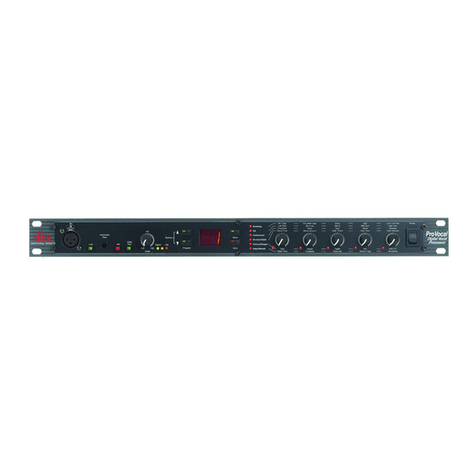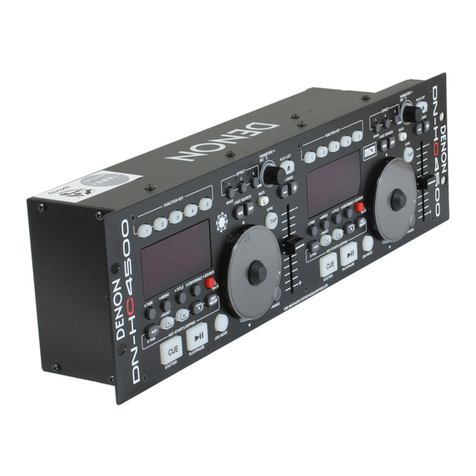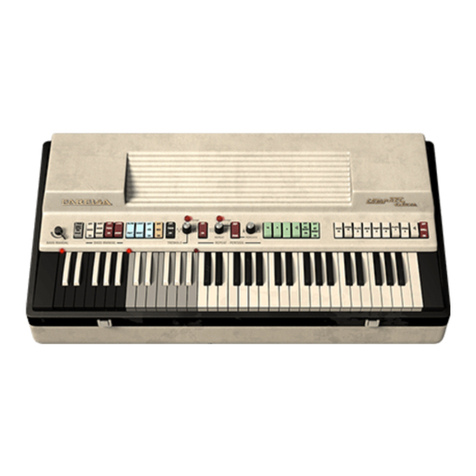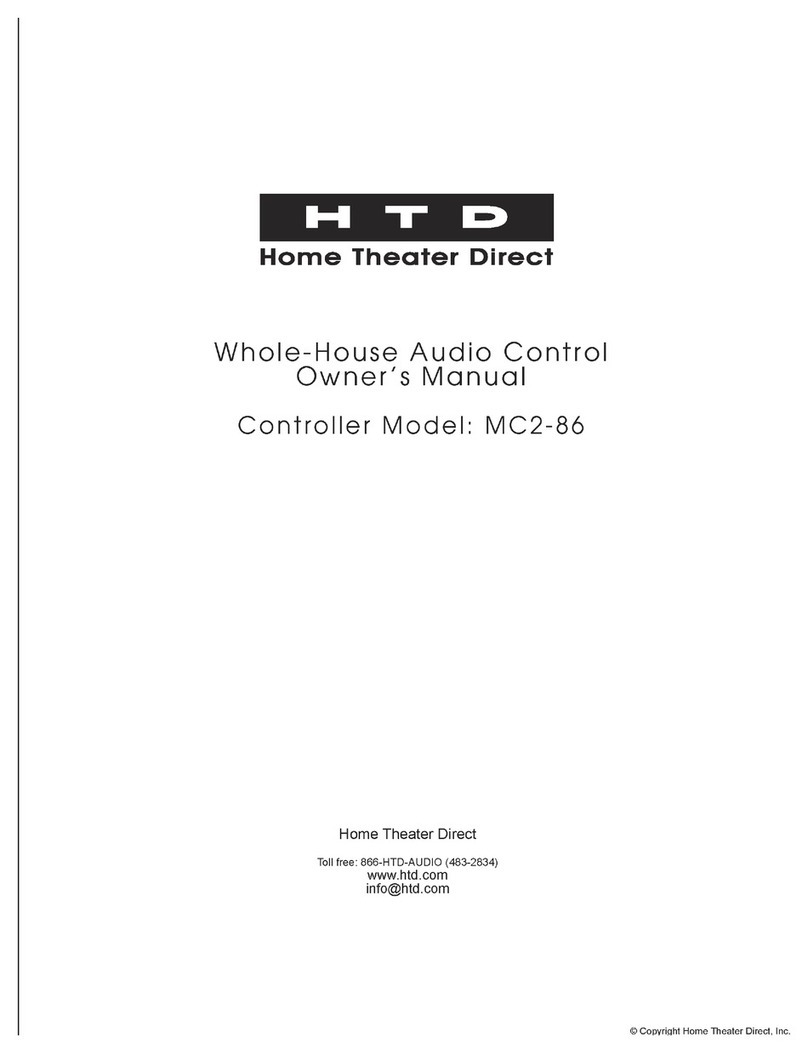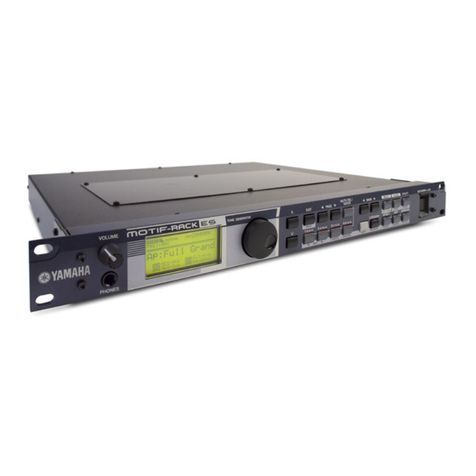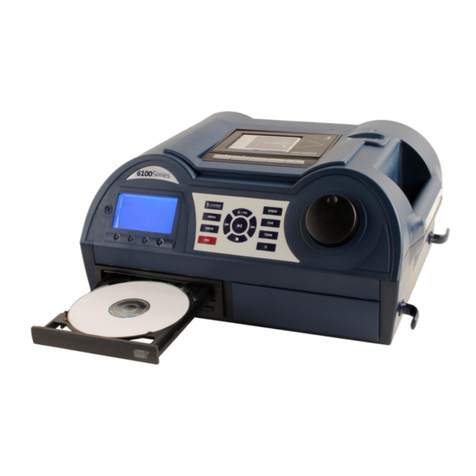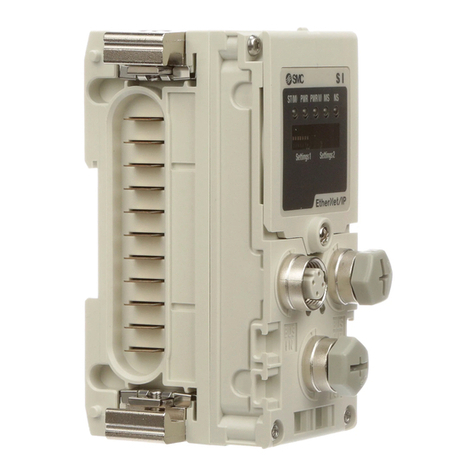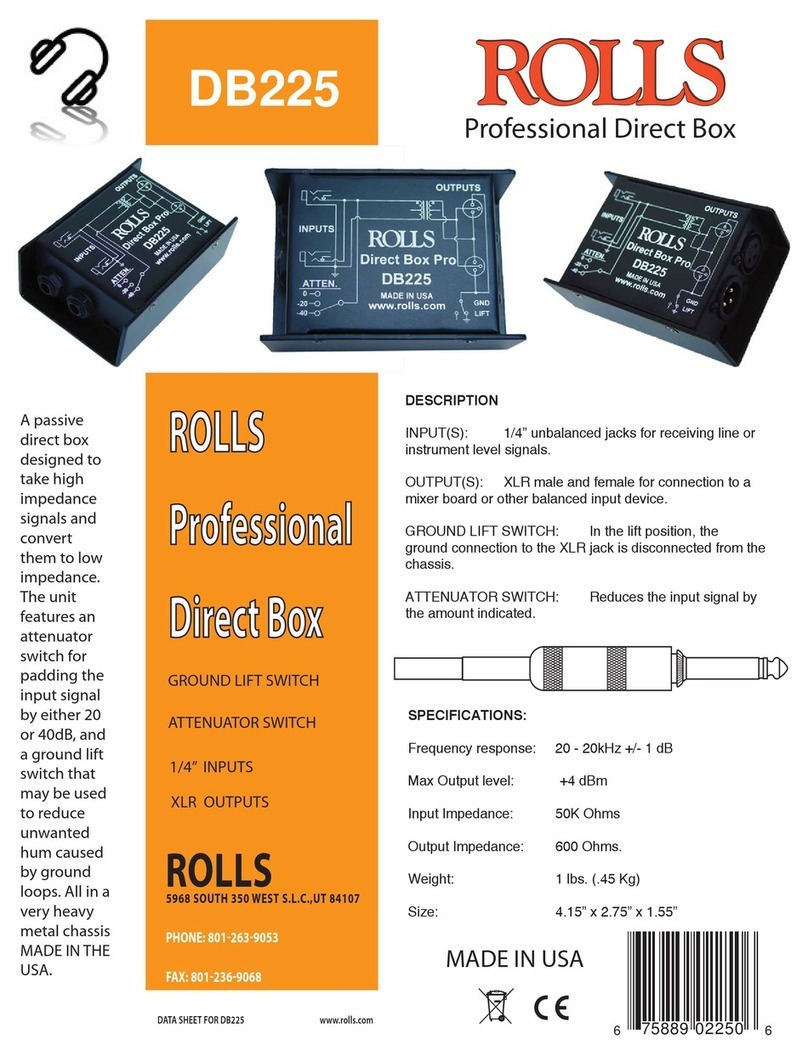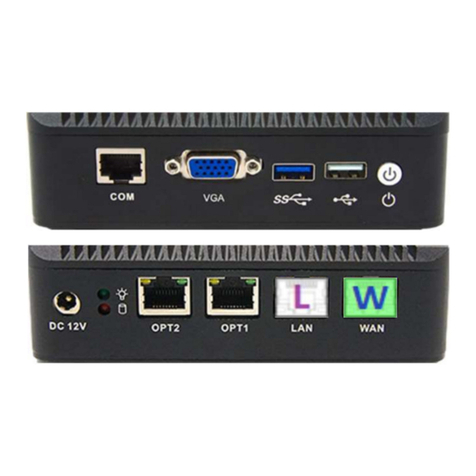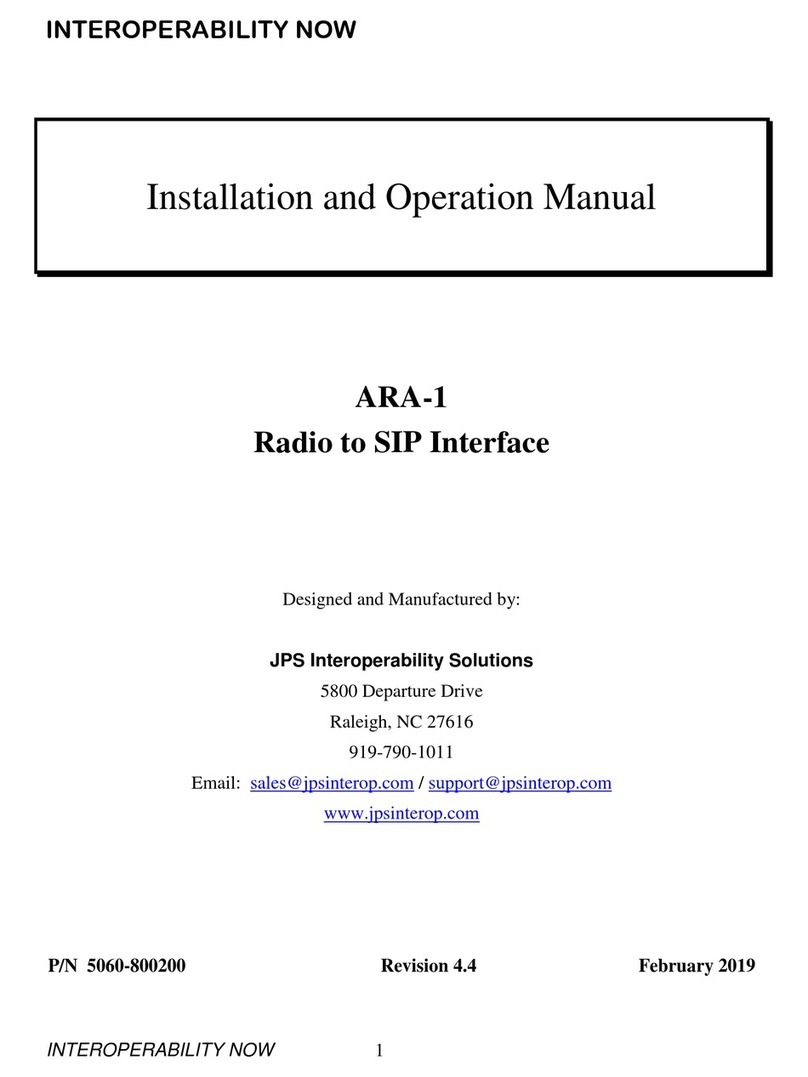PS Engineering PMA8000B--MP3 User manual

9800 Martel Road
Lenoir City, TN 37772
www.ps-engineering.com
P
PM
MA
A8
80
00
00
0B
B-
-M
MP
P3
3
F
FO
OR
R
U
US
SE
E
W
WI
IT
TH
H
A
Av
vi
id
dy
yn
ne
e
E
En
nt
te
eg
gr
ra
a
I
In
nt
te
eg
gr
ra
at
te
ed
d
A
Av
vi
io
on
ni
ic
cs
s
S
Sy
ys
st
te
em
m
R
R9
9
Document P/N 200-890-0403
Rev. 4, Jan. 2011
Audio Selector Panel with Marker Beacon Receiver
High-fidelity Stereo Intercom with Internal MP3 Player
System Installation and Operation Manual
FAA- TSO C50c, C35d
EASA ETSO C50c, 2C35d
Patented under one or more of the following;
No. 4,941,187; 5,903,227; 6,160,496 and 6,493, 450
PS Engineering, Inc. 2011 ©
Copyright Notice
Any reproduction or retransmittal of this publication, or any portion thereof, without the expressed written permission of PS Engi-
neering, Inc. is strictly prohibited. For further information contact the Publications Manager at PS Engineering, Inc., 9800 Martel
Road, Lenoir City, TN 37772. Phone (865) 988-9800, email contact@ps-engineering.com.
In certified aircraft, warranty is not valid unless this product is installed by an
Authorized PS Engineering dealer.

Table of Contents
Section I – GENERAL INFORMATION........................................................................................................... 1-1
1.1 INTRODUCTION..................................................................................................................................... 1-1
1.2 SCOPE....................................................................................................................................................... 1-1
1.3 EQUIPMENT DESCRIPTION................................................................................................................. 1-1
1.4 APPROVAL BASIS .................................................................................................................................. 1-2
1.5 SPECIFICATIONS................................................................................................................................... 1-2
1.6 EQUIPMENT SUPPLIED ........................................................................................................................ 1-4
1.7 EQUIPMENT REQUIRED BUT NOT SUPPLIED.................................................................................. 1-4
1.8 OPTIONAL ITEMS.................................................................................................................................. 1-4
1.9 LICENSE REQUIREMENTS................................................................................................................... 1-4
Section II - INSTALLATION ............................................................................................................................ 2-1
2.1 GENERAL INFORMATION.................................................................................................................... 2-1
2.1.1 SCOPE.................................................................................................................................................... 2-1
2.1.2 CERTIFICATION REQUIREMENTS ................................................................................................................. 2-1
2.2 UNPACKING AND PRELIMINARY INSPECTION ................................................................................................. 2-1
2.3 EQUIPMENT INSTALLATION PROCEDURES ..................................................................................................... 2-1
2.3.1 COOLING REQUIREMENTS .......................................................................................................................... 2-1
2.3.2 MOUNTING REQUIREMENTS ....................................................................................................................... 2-1
2.3.3 AUDIO PANEL MOUNTING RACK INSTALLATION ........................................................................................... 2-2
2.3.4 AUDIO PANEL TRAY AND CONNECTOR ASSEMBLY........................................................................................ 2-2
2.4 CABLE HARNESS WIRING............................................................................................................................. 2-2
2.4.1 NOISE ...................................................................................................................................................... 2-2
2.4.2 EXISTING GMA340 INSTALLATION............................................................................................................. 2-3
2.4.3 POWER..................................................................................................................................................... 2-3
2.4.4 COMMUNICATIONS PUSH-TO-TALK ............................................................................................................. 2-3
2.4.5 AUDIO PANEL INTERFACE .......................................................................................................................... 2-4
2.4.6 TEL (DUPLEX) FUNCTION FOR CELL PHONES .............................................................................................. 2-4
2.4.7 TRANSMIT INTERLOCK............................................................................................................................... 2-4
2.4.8 BACKLIGHTING ......................................................................................................................................... 2-5
2.4.9 UNSWITCHED INPUTS................................................................................................................................. 2-5
2.4.10 AVIDYNE ENTEGRA SPECIAL INTERFACE ................................................................................................... 2-5
2.4.11 PUBLIC ADDRESS MODE.......................................................................................................................... 2-6
2.4.12 PA MUTE (J2, PIN 12) ............................................................................................................................ 2-7
2.5 INTERCOM WIRING....................................................................................................................................... 2-7
2.5.1 ENTERTAINMENT INPUTS ........................................................................................................................... 2-7
2.5.2 ENTERTAINMENT MUTING.......................................................................................................................... 2-8
2.5.3 CONFIGURING MUSIC INPUT WITH FUNCTION KEYS ...................................................................................... 2-8
2.5.4 PLAYBACK BUTTON INSTALLATION.............................................................................................................. 2-8
2.6 MARKER BEACON INSTALLATION................................................................................................................. 2-9
2.6.1 MARKER ANTENNA INSTALLATION ............................................................................................................. 2-9
2.6.2 EXTERNAL MARKER LIGHTS....................................................................................................................... 2-9
2.6.3 MIDDLE MARKER SENSE ........................................................................................................................... 2-9
2.7 ADJUSTMENTS ............................................................................................................................................. 2-9
2.8 COMMUNICATIONS ANTENNA INSTALLATION NOTES ................................................................................... 2-10
2.8.1 AUDIO ACTIVE OUTPUT............................................................................. ERROR! BOOKMARK NOT DEFINED.
2.9 PMA8000B-MP3 PIN ASSIGNMENTS.......................................................................................................... 2-11
2.10 POST INSTALLATION CHECKOUT .............................................................................................................. 2-12
2.11 UNIT INSTALLATION................................................................................................................................. 2-12
2.12 OPERATIONAL CHECKOUT....................................................................................................................... 2-12
2.12.1 REQUIRED TEST EQUIPMENT.................................................................................................................. 2-12
2.12.2 AUDIO PANEL TEST............................................................................................................................... 2-12
2.12.3 MARKER CHECKOUT ............................................................................................................................. 2-13
2.12.4 TEL CHECKOUT ................................................................................................................................... 2-13
2.12.5 INTERNAL RECORDER CHECKOUT ........................................................................................................... 2-13
2.12.6 FUNCTION BUTTON CHECKOUT .............................................................................................................. 2-13
2.12.7 MP3 PLAYER CHECKOUT ...................................................................................................................... 2-13
2.13 FINAL INSPECTION ................................................................................................................................... 2-14

PS Engineering
PMA8000B-MP3Avidyne Version (-0403) Audio Selector Panel and Intercom System
Installation and Operator’s Manual
200-890-0403 Page ii Rev. 4, Jan. 2011
Section III OPERATION ............................................................................................................................... 3-1
3.1 SCOPE....................................................................................................................................................... 3-1
3.2 COMMUNICATIONS TRANSMIT (XMT) SELECTION (2)................................................................................... 3-1
3.3 AUDIO SELECTOR (4) ................................................................................................................................... 3-2
3.3.1 MONITOR (MON) FUNCTION (11) ............................................................................................................... 3-2
3.4 TELEPHONE (TEL) (9)................................................................................................................................. 3-2
3.5 SPEAKER AMPLIFIER (5) .............................................................................................................................. 3-3
3.6 MARKER BEACON OPERATION (10).............................................................................................................. 3-3
3.7 INTERCOM OPERATION ................................................................................................................................ 3-4
3.7.1 INTELLIVOX® VOX-SQUELCH.................................................................................................................... 3-4
3.7.2 INTERCOM VOLUME CONTROL (7)............................................................................................................... 3-4
3.7.3 INTERCOM MODES (8) ............................................................................................................................... 3-5
3.8 MUSIC MUTING (6) ...................................................................................................................................... 3-5
3.9 TELEPHONE MODE (9)................................................................................................................................. 3-6
3.10 UTILITY JACK ............................................................................................................................................ 3-7
3.10.1 CELLULAR PHONE ................................................................................................................................... 3-7
3.10.2 AUDIO ADVISORY INPUT.......................................................................................................................... 3-7
3.10.3 MUSIC INPUT.......................................................................................................................................... 3-7
3.10.4 SMART FUNCTION KEYS (SFK)................................................................................................................ 3-7
3.10.5 FUNCTION “A” ....................................................................................................................................... 3-9
3.10.6 FUNCTION “B” ....................................................................................................................................... 3-9
3.10.7 FUNCTION “C” ....................................................................................................................................... 3-9
3.11 MP3 MUSIC CONTROLS........................................................................................................................... 3-10
3.12 MP3 PLAYER OPERATION ....................................................................................................................... 3-10
3.13 MUSIC 1 & MP3 VOLUME (H & I) ............................................................................................................ 3-11
3.14 FILE TRANSFER ....................................................................................................................................... 3-11
3.14.1 LAPTOP TRANSFER ................................................................................................................................ 3-11
3.14.2 TRANSFER USING USB DRIVE ................................................................................................................ 3-12
3.15 INTERNAL RECORDER.............................................................................................................................. 3-13
3.15.1 PLAYBACK ........................................................................................................................................... 3-13
Section IV – Warranty and Service.................................................................................................................... 4-1
4.1 WARRANTY ................................................................................................................................................. 4-1
4.2 FACTORY SERVICE....................................................................................................................................... 4-1
Appendix A – External PTT Hook Up..................................................................................................................A
Appendix B – PMA 8000 Installation Drawings...................................................................................................B
Appendix C – J1 Connector Interconnect (-0403) .................................................................................................C
Appendix D – J2 Connector Interconnect (-0403 only) .........................................................................................D
Appendix E – Instructions for FAA Form 337 and continuing airworthiness ......................................................... E
9.1 INSTRUCTIONS FOR FAA FORM 337, AUDIO PANELS........................................................................................E
9.2 INSTRUCTIONS FOR CONTINUING AIRWORTHINESS, AUDIO SYSTEM ..................................................................E
Appendix F – RTCA DO160D Environmental Qualification Form ....................................................................... F
Rev
Date
Change
New
6/8/09
Created for PMA8000B-MP3 MP3 Avidyne version
1
9/8/09
Clarified Shift Function legends
2
11/10/09
Updated TEL Sidetone operation, Pilot Music in ISO, functions.
3
10/18/2010
Clarified the Music 1 all headsets function §3.11.3
4
1/5/11
Improved grounding lug installation, Appendix B

PS Engineering
PMA8000B-MP3Avidyne Version (-0403) Audio Selector Panel and Intercom System
Installation and Operator’s Manual
200-890-0403 Page 1-1 Rev. 4, Jan. 2011
Section I – GENERAL INFORMATION
1.1 INTRODUCTION
The PMA8000B-MP3 represents another evolutionary step in cockpit audio control and intercommunica-
tions utility. Using our patented IntelliVox® design, front panel utility jack, and pilot programmable con-
figurations, and internal MP3 player, this marks the next level of audio control. The unit is designed for
outstanding ergonomics and visually defined mode annunciation and selection.
Before installing and/or using this product, please read this manual completely. This will ensure that you
will take full advantage of all the advanced features in the PMA8000B-MP3.
1.2 SCOPE
This manual provides detailed installation and operation instr uctions for the PS Engineering PMA8000B-
MP3-series of Audio Selector Panel/Intercom Systems. This includes the following units:
Model
Description
Part Number
PMA8000B-MP3
Stereo Audio Selector Panel with Marker Beacon, includes
utility jack and Internal Recorder System with internal 1G
MP3 player For Avidyne Entegra Integrated Flight Display
System Release 9.
050-890-0403
1.3 EQUIPMENT DESCRIPTION
This audio selector panel was developed for use with the Avidyne Entegra Integrated Flight Display Sys-
tem Release 9. The following features are provided when the PMA8000B audio panel, P/N 050-890-0403,
is installed.
Marker beacons indications displayed on IFD as well as audio panel.
Monitor buttons (Mon1 and Mon2) when selected, allow the user to monitor (listen only) the
Standby frequencies of the Com1 and Com2 radio modules respectively.
When a DME is installed in the aircraft the Mon2 button provides the ability to monitor the
Morse code associated with the DME. DME audio will be routed to this channel (Mon2) instead
of the Com2 Standby.
Ability to display decoded active frequency on IFD based on crew audio panel selection.
The PMA8000B-MP3 is a state-of-the-art audio isolation amplifier and audio selector that contains an
automatic voice activated (VOX) intercom system and integral marker beacon receiver. It can switch two
transceivers (Com 1, Com 2) and six receivers (Nav 1, Nav 2, ADF, DME, MKR and AUX).
The PMA8000B-MP3 version (050-890-0602) incorporates an internal MP3 Player with one gigabyte of
memory. This is controlled through secondary functions on the front panel.
A full duplex TEL mode allows the PMA8000B-MP3 to act as an audio interface between aircraft head-
phone and microphones and specific aircraft approved (FAA/FCC) cellular telephone equipment, through
the front mounted jack.
Warning: Use of non-aviation approved cellular telephone equipment may be prohibited by regulation.
PS Engineering is not responsible for unauthorized airborne use of cellular telephones.
For airborne use, the PMA8000B-MP3 must be interfaced with an approved system.

PS Engineering
PMA8000B-MP3Avidyne Version (-0403) Audio Selector Panel and Intercom System
Installation and Operator’s Manual
200-890-0403 Page 1-2 Rev. 4, Jan. 2011
There are five unswitched inputs, available for traffic or EGPWS, autopilot disconnect, and/or radar a l-
timeter warning, with the fifth unswitched input through a front -mounted utility jack, when configured to
act as a fifth unswitched input.
Pushbuttons select the receiver audio source provided to the headphones. A SPR button allows the user to
listen to the receiver(s) selected on the cabin speaker. Except for the unswitched inputs, all speaker audio
is muted during transmit. Unswitched inputs 1,3, and 4 are always presented to the aircraft speaker.
Unswitched input 2 will be presented to the speaker when the front panel SPR push button has been se-
lected.
Pushbutton switches select one of the communication transceivers for the pilot and copilot position, and
allows radio transmission. In "Split Mode" the PMA8000B-MP3 has the ability to allow the pilot to
transmit on Com 1 while the copilot can transmit on Com 2. A fail -safe mode connects the pilot head-
phone and microphone to COM 1 if power is removed for any reason, or if the power switch is placed in
the Off (Fail-safe) position. Unswitched input #1 is also provided to the pilot headphone in fail-safe
A six-station voice activated (VOX) intercom is included in the PMA8000B-MP3. This system has PS
Engineering’s patented IntelliVox® circuitry that eliminates manual adjustments. The intercom system
incorporates pilot isolate, all and crew modes, two independent stereo music inputs with "SoftMute™".
Intercom volume control is through two concentric front panel knobs and a pushbutton intercom mode
switch. The small volume knob controls the intercom level for the pilot and copilot, while the large knob
controls the passenger intercom volume. Intercom squelch is automatic.
A 3-light, 75 MHz Marker Beacon receiver is integrated in the PMA8000B-MP3. This provides the neces-
sary Marker Beacon lights and audio indications necessary for that portion of an Instrument Landing Sys-
tem (ILS) approach. A pushbutton labeled MKR allows the pilot select high or low sensitivity as well as
test and mute modes.
1.4 APPROVAL BASIS
FAA TSO Approval.
The PMA8000B-MP3-series Audio Selector Panels are FAA approved under TSO C50c (Audio Amplifi-
ers) and TSO C35d (Marker Beacon Receivers), ETSO C50C/ and 2C53d.
All systems comply with relevant portions of EUROCAE RTCA MPS WG No. 7/70, DO-143 and (Marker
Beacon Receivers), ED-14C/DO-160C (Environmental Conditions and Test Procedures for Airborne
Equipment), ED12B/DO-178B, Level D (Software Considerations for Airborne Equipment) and ED-
18/DO-214 (Audio Systems Characteristics and Minimum Operational Performance Standards for Air-
craft Audio Systems).
Operation is subject to the following conditions:
This device may not cause harmful interference.
This device must accept any interference received, including interference that may cause undesired oper a-
tion.
1.5 SPECIFICATIONS
TSO COMPLIANCE
Marker Beacon:
FAA TSO C35d, Class A ETSO 2C35d
Audio Selector/Intercom:
FAA TSO C50c, Class 1a ETSO C50c
APPLICABLE DOCUMENTS:
RTCA/DO-214 RTCA/DO-143 RTCA/DO-160D
RTCA/DO-178B DO-254
ENVIRONMENTAL Qualifications:
A1D1CABSMXXXXXXZBABATBXXE2XXX
Operating Temperature Range:
-15º C to 55ºC
Altitude:
Up to 50,000 feet in an non-pressurized area
DIMENSIONS:
Height: 1.3 in. (3.3 cm) Width: 6.25 in. (16.9 cm)
Depth behind panel 7.15 in. (18.16 cm)

PS Engineering
PMA8000B-MP3Avidyne Version (-0403) Audio Selector Panel and Intercom System
Installation and Operator’s Manual
200-890-0403 Page 1-3 Rev. 4, Jan. 2011
WEIGHT
PMA8000B-MP3 Unit
Rack with connectors
1.34 lb. (0.61 kg)
0.51 lb. (0.24 kg)
POWER REQUIREMENTS (Including Internal Lighting):
Voltage:
11 to 33 VDC
Maximum Current:
2.5 Amp (Externally protected by a 5A pull-type
breaker)
Audio Selector Specifications
Audio selector panel input impedance:
510
Input Isolation:
-60 dB (min.)
Speaker Muting:
-60 dB (min.)
Speaker Output (into 4 ) with no clipping
14 VDC:
28 VDC:
3 Watts (min.)
10 Watts (min.)
Receiver Inputs:
9 (Com 1, Com 2, TEL, Nav 1, Nav 2, DME, Mon1,
Mon2)
Unswitched Inputs:
5 (including front jack)
Transmitter Selections:
4 (Com 1, Com 2, TEL
Com1/2)
Speaker Impedance:
4
Headphone Impedance:
150 – 1000
Headphone Output:
38 mW each headset, no clipping <1% THD typical
Microphone Impedance:
150 - 600
Intercom Specifications
Intercom Positions:
6 places (with individual IntelliVox® circuits)
Music Inputs:
2, (Independent, Stereo)
Music Muting:
>-30 dB "Soft Mute" when Com or intercom active.
Distortion:
<1% THD @ 38 mW into 150
Mic Freq. Response, 3 dB:
300 Hz - 6000 Hz
Music Freq. Response, 3 dB:
10 Hz – 26 kHz
MARKER BEACON RECEIVER:
Frequency:
75 MHz Crystal Controlled
Sensitivity:
Low:
High:
Capable of: (preset at factory for field application)
1000 Volts (Hard) (360 to 570 V soft)
200 Volts (Hard) (130 to 200 V soft)
Selectivity:
-6 dB at ±10 kHz
-40 dB at ±120 kHz
External Lamp Output:
7.5 (±4 VDC unloaded, at maximum brightness) VDC
positive when active, max. current 125 mA
MM Sense:
Active high (4.5 ± 1.0VDC)

PS Engineering
PMA8000B-MP3Avidyne Version (-0403) Audio Selector Panel and Intercom System
Installation and Operator’s Manual
200-890-0403 Page 1-4 Rev. 4, Jan. 2011
1.6 EQUIPMENT SUPPLIED
1 ea. of the following units:
Model
Description
Part Number
PMA8000B-MP3
PMA8000B-MP3 Audio Panel with Marker Beacon and Stereo
intercom, includes internal 1G MP3 Player, for use with Avidyne
Entegra Integrated Display System
050-890-0403
PMA8000B- Installation Kit: 250-890-0000
Description
Quantity
Part
Number
PMA8000B-MP3 installation rack assembly
1
430-890-0040
PMA8000B-MP3 Rack back plate
1
430-890-0050
44-pin connector kit
2
120-891-2045-
Backshell, connector
2
625-025-2465
Backshell Retainer
2
431-881-0100
4 40 X 7/16 screw w/nylon patch
4
475-440-0007
4 40 X 3/8 screw w/nylon patches
4
475-440-1038
4-40 x ¼” screw with lock washer
2
475-440-0001
Solder Lug
2
475-009-0001
Cable Clamp
1
625-001-0002
#6-32 x ½” Flat head Philips screw
6
475-632-0012
#6-32 Clip Nut
6
475-630-0002
Included with PMA8000B-MP3:
Cable, USB to 2.5 mm 4-conductor, PS Part Number 425-921-3983
USB-to-USB adapter PS Part number 425-003-1454
1.7 EQUIPMENT REQUIRED BUT NOT SUPPLIED
a. Circuit Breaker: 1 ea; 5 amp PULL TYPE REQUIRED for PMA8000B-MP3
b. Speaker, 4
c. Headphone Jacks (Stereo, as Required)
d. Microphone Jacks (as Required)
e. Headphones, 150 (Stereo), up to 6 as required
f. Microphones, up to 6 as required
g. Marker Antenna (75 MHz, VSWR <1:1.5, and appropriate for the airspeed)
h. Interconnect Wiring
1.8 OPTIONAL ITEMS
a. Cell Phone Patch Cord, 2.5mm to 2.5mm, PS Part Number 425-006-7026
b. Music Patch Cord, 3.5mm to 5.5mm, PS Part Number 425-006-2535
c. Phone patch cord for iPhone or Blackberry 3.5 mm 4-conductor to 2.5 mm
(Phone only, no music) 425-006-0354
1.9 LICENSE REQUIREMENTS
None
Note: The PMA8000B-MP3 Avidyne only supports Wave (.wav), unprotected Windows Media Files
(.wma) and MP3 (.mp3) file types. It does not support iTunes format files.

PS Engineering
PMA8000B-MP3Avidyne Version (-0403) Audio Selector Panel and Intercom System
Installation and Operator’s Manual
200-890-0403 Page 2-1 Rev. 4, Jan. 2011
Section II - INSTALLATION
2.1 GENERAL INFORMATION
2.1.1 SCOPE
This section provides detailed installation and interconnection instructions for the PS Engineering
PMA8000B-MP3 Audio Selector Panel/Intercom/ with internal Marker Beacon.
Please read this manual carefully before beginning any installation to prevent damage and post -
installation problems. Installation of this equipment requires special tools, test equipment (refer to section
2.12.1) and knowledge as required by 14 CFR 65.81 (b).
Refer to Avidyne Entegra Integrated Avionics System Installation Manual for full systems interconnect.
2.1.2 Certification Requirements
NOTE
The PMA8000B-MP3 requires specialized knowledge and tools for an effective installation. An appropri-
ately rated Certified Aircraft Repair Station must install this equipment in accordance with applicable
regulations. PS Engineering, Incorporated warranty is not valid unless the equipment is installed by an
authorized PS Engineering, Incorporated dealer.
Failure to follow any of the installation instructions, or installation by a non -certified individual or agency
will void the warranty, and may result in an unairworthy installation.
2.2 Unpacking and Preliminary Inspection
Use care when unpacking the equipment. Inspect the units and parts supplied for visible signs of shipping
damage. Examine the unit for loose or broken buttons, bent knobs, etc. Verify the correct quantity of
components supplied with the list in Section 1.6 (B). If any claim is to be made, save the shipping mat e-
rial and contact the freight carrier. Do NOT return units damaged in shipping to PS Engineering. If the
unit or accessories show any sign of external shipping damage, contact PS Engineering to arrange for a
replacement. Under no circumstances attempt to install a damaged unit in an aircraft. Equipment returned
to PS Engineering for any other reason should be shipped in the original PS Engineering packaging, or
other UPS approved packaging.
2.3 Equipment Installation Procedures
2.3.1 Cooling Requirements
Forced air-cooling of the PMA8000B-MP3 is not required. However, the units should be kept away from
heat producing sources (i.e. defrost or heater ducts, dropping resistors, heat producing avionics) without
adequate cooling air provided.
2.3.2 Mounting Requirements
The PMA8000B-MP3 must be rigidly mounted to the instrument panel of the aircraft structure, within
view and reach of the pilot position(s). Installation must comply with FAA Advisory Circular AC 43.13-
2B. The unit may be mounted in any area where adequate clearance for the unit and associated wiring
bundle exist.
To prevent noise, avoid installing the unit close to high current devices or systems with high-voltage pulse
type outputs, such as DME or transponders. Avoid running the interconnecting bundles near any high
current wires.

PS Engineering
PMA8000B-MP3Avidyne Version (-0403) Audio Selector Panel and Intercom System
Installation and Operator’s Manual
200-890-0403 Page 2-2 Rev. 4, Jan. 2011
2.3.3 Audio Panel Mounting Rack Installation
Remove the unit from the mounting tray by unscrewing the 3/32" hex-head screw that is in the center of
the unit. Use caution to avoid hitting the photo-detector lens. Carefully slide the unit free of the tray. Set
the unit aside in a safe location until needed. Install the tray using six clip nuts (475 -630-0002), and six
FHP 6-32 x ½" screws (475-632-0012). The audio selector panel must be supported at front and rear of
the mounting tray.
2.3.4 Audio Panel Tray and Connector Assembly
The rack connectors mate with two 44-pin connectors in the PMA8000B-MP3. The connectors are a sub-
miniature crimp-type, and require the use a hand crimp tool, from table below (or equiv.). The connectors
are mounted to the tray back plate with #4-40 screws (475-440-1038), from the inside of the tray and the
mounting block, 431-891-0100. Ensure that proper strain relief and chafing precautions are made during
wiring and installation, using the cable clamp (625-001-0002).
Two grounding lugs are provided, which may be attached to the rear mounting plate with 2 ea #4 -40 x ¼”
screws with captivated lock washers. These provide a convenient location to connect the shield ground
terminations.
Manufacturer
Crimping Tool
Positioner
Extraction tool
AMP
601966-1
601966-6
91067-1
Daniels
AFM8
K42
M24308-1
ITT-Cannon
995-0001-584
995-0001-739
91067-1
Table 2-1 Connector Pin crimping tools
2.4 Cable Harness Wiring
Referring to the appropriate Appendix, assemble a wiring harness as required for the installation. All
wires must be MIL-SPEC in accordance with current regulations. Two- and three-conductor shielded wire
must be used where indicated, and be MIL-C-27500 or equivalent specification. Proper stripping, shield-
ing and soldering technique must be used at all times. It is imperative that correct wire be used.
Refer to FAA Advisory Circular 43.13-2B for more information. Failure to use correct techniques may
result in improper operation, electrical noise or unit failure. Damage caused by improper installation will
void the PS Engineering warranty.
2.4.1 Noise
Due to the variety and the high power of radio equipment often found in today's general aviation aircraft,
there is a potential for both radiated and conducted noise interference.
The PMA8000B-MP3 power supply is specifically designed to reduce conducted electrical noise on the
aircraft power bus by at least 50dB. Although this is a large amount of attenuation, it may not eliminate
all noise, particularly if the amplitude of noise is very high. There must be at least 13.8 VDC present at
the connector, J2 pins 8 & 9, of the PMA8000B-MP3 for the power supply to work in its designed regula-
tion. Otherwise, it cannot adequately attenuate power line noise. Shielding can reduce or prevent radiated
noise (i.e., beacon, electric gyros, switching power supplies, etc.) However, installation combinations can
occur where interference is possible. The PMA8000B-MP3 was designed in a RFI hardened chassis and
has internal Electromagnetic Interference (EMI) filters on all inputs and outputs.
Ground loop noise occurs when there are two or more ground paths for the same signal (i.e., airframe and
ground return wire). Large cyclic loads such as strobes, inverters, etc., can inject noise signals onto the
airframe that are detected by the audio system. Follow the wiring diagram very ca refully to help ensure a
minimum of ground loop potential. Use only Mil Spec shielded wires (MIL-C-275000, or better). Under
no circumstances combine a microphone and headphone wiring into the same shielded bundle. Always
use a 2- or 3-conductor, shield wire as shown on the installation-wiring diagram.

PS Engineering
PMA8000B-MP3Avidyne Version (-0403) Audio Selector Panel and Intercom System
Installation and Operator’s Manual
200-890-0403 Page 2-3 Rev. 4, Jan. 2011
The shields can be daisy-chained together, and then connected to the ground lugs mounted on the back
plate shown in Appendix B.
Radiated signals can be a factor when low level microphone signals are "bundled" with current carrying
power wires. Keep these cables physically separated. It is very important that you use insulated washers to
isolate the ground return path from the airframe to all headphone and microphone jacks.
2.4.1.1 Music Inputs and Noise
PMA8000B-MP3 units utilize a differential input to help prevent noise from ente ring the music system.
This feature is usually transparent to the installer, however, it is important that the appropriate music si g-
nal and ground connections are made directly to the dedicated music signal and ground inputs on the
PMA8000B-MP3. The power for IFE and audio panel should be a common bus.
If a music jack is installed for Music 1 or 2, we strongly recommend isolating the jack from airframe
ground, by using an insulated mounting plate.
NOTE
Adding a high-performance audio control system, particularly in conjunction with high -performance ac-
tive noise canceling headsets, cannot improve on older avionics that were designed for cabin -speaker use.
PS Engineering makes no claim that the audio panel will provide a noise-free audio quality under all in-
stallation conditions, particularly with older avionics.
2.4.2 Existing GMA340 Installation
If the installation replaces a GMA340, no changes are necessary as long as the existing installation meets
the requirements. All existing functions of the GMA340 as well as all of the new capabilities afforded by
the PMA8000B-MP3 will become instantly available. Be advised, the PMA8000B-MP3 does not support 3
VHF Coms, however. The PMA8000B-MP3 handles two COM transceivers and a full-duplex cellu-
lar/satellite telephone.
Added capabilities include, IntelliVox®, DuTel™ duplex telephone, internal MP3 player, improved music
fidelity and Soft Mute™ and Karaoke™ muting modes, improved and more flexible music distribution
control, internal recorder function, and additional unswitched audio inputs.
Installations where the external marker outputs are connected to a Sandel 3308 Navigation Display will
require additional loading resistors. Refer to the Sandel installation data for more information.
2.4.3 Power
The PMA8000B-MP3 is compatible with both 14 and 28 Volt DC systems. A five (5) Amp circuit breaker
is required for all installations. Power and ground wires should be #22 connected to J2 Pins 8 and 9. Con-
nect airframe ground to J2 Pin 10 and 11 only. No dropping resistors are required.
2.4.4 Communications Push-to-Talk
An important part of the installation is the PTT (Push -To-Talk) switches that allow the use of your air-
craft communications radio for transmissions. There are three typical configurations that can be used.
Select the case that best fits the installation. Only the person who presses their PTT switch will be heard
over the radio. If the pilot and copilot both use the PTT, the only pilot position has access to the radio.
The pilot position will have PTT control regardless of the mic selector switch or copilot PTT when the
PMA8000B-MP3 is in the OFF/EMG mode.
CASE I: PTT is built into both pilot and copilot yokes.
CASE II: PTT is in pilot yoke only. This configuration requires a modified external PTT switch plugged
into the copilot's microphone jack. (See Appendix A). When the copilot's PTT is pressed, the intercom
switches the microphone audio from pilot to copilot mic.
CASE III: No built in PTT. This requires two built in PTTs to be installed, or modified external PTT
switches to be used. Modify external PTT as required. See Appendix A.

PS Engineering
PMA8000B-MP3Avidyne Version (-0403) Audio Selector Panel and Intercom System
Installation and Operator’s Manual
200-890-0403 Page 2-4 Rev. 4, Jan. 2011
2.4.5 Audio Panel interface
The PMA8000B-MP3 is designed to interface with standard aircraft avionics, and presents a 510 re-
ceiver impedance. For best results, a twisted-shielded cable is recommended from the avionics audio
source to the audio panel, with the shield grounded at the audio panel end.
Some avionics do not provide a separate audio low, and may introduce additional electrical noise into the
system. For best results, connect the audio low from the audio panel to the radio ground, using one con-
ductor of the twisted-shielded cable.
2.4.6 TEL (Duplex) Function for Cell Phones
This mode is designed to operate with telecommunications systems, such as the AirCell Guardian 1000.
Audio streams selected by the intercom mode are provided to the Tel output, and audio from Tel is pr e-
sented to the headset. This allows a telephone-like audio interface.
The TEL mode in the PMA8000B-MP3 is also compatible with many cellular telephones with hands-free
headset interfaces. The front panel 3/32” utility jack can be used as the interface to the Cell Phone, or a
3/32” jack can be installed somewhere on the aircraft panel. The wired interface jack is connected with
the PMA8000B-MP3 as shown: A patch cord (3/32” to 3/32”) is available from PS Engineering under
P/N 425-006-7026.
3/32" Cellular Jack
COM 3 Mic Input
Com 3 Audio
Audio Lo
Cellular Plug (typical)
Tip= Microphone out
Ring= Speaker audio
Base=Ground
This is a typical interconnect
PS Engineering does not guarantee
compatability in all cases.
Cellular Phone
Interconnect
Figure 2-1 Cellular telephone interface for rear connector, if an additional jack is desired
2.4.6.1 Cell phone Sidetone
As shipped from PS Engineering, the PMA8000B-MP3 does not provide cellular telephone sidetone (the
user’s voice fed back to the headset). Some cell phones do not provide sidetone. In PMA8000B MP3
Avidyne audio panels above serial number C10251, Telephone sidetone can be enabled by pressing the
MON 1 and TELK buttons for more than one second. For units with serial number C10250 and below, an
internal modification can be made that will allow the PMA8000B -MP3 to provide this sidetone. Contact
PS Engineering for more information.
NOTE
Unauthorized use of unapproved cellular telephone devices in aircraft is subject to FCC enforcement ac-
tion, which may include a $10,000 fine per incident. PS Engineering, Inc. does not endorse using unap-
proved cellular telephone equipment in flight, and takes no responsibility for the user’s action.
PS Engineering does not guarantee compatibility with personal cellular telephones. For a list of phones
that have been tested, visit www.ps-engineering.com.
2.4.7 Transmit Interlock
Some communications transceivers use a transmit-interlock system. To fully utilize the Split Mode fea-
ture, this function must be disabled. Consult that manufacturer's installation ma nual.

PS Engineering
PMA8000B-MP3Avidyne Version (-0403) Audio Selector Panel and Intercom System
Installation and Operator’s Manual
200-890-0403 Page 2-5 Rev. 4, Jan. 2011
2.4.8 Backlighting
The PMA8000B-MP3 has an automatic dimming of the pushbutton annunciation LEDs and marker lamps
controlled by a photocell. Control of the unit backlighting is through the aircraft avionics dimmer For 14
V aircraft, connect J2 Pins 6 and 7 to the aircraft dimmer bus, and pin 5 to ground. For 28-volt systems,
connect pin 7 to the aircraft dimmer, and pins 5 and 6 to ground.
If an external dimmer control is not used, a constant back light illumination can be established for nigh t-
time viewing. Pin 6 or 7 (depending on system voltage) must be tied to power (J2, pin 8 or 9) for the back
lighting system to work. The photocell mounted in the unit face will automatically adjust the intensity of
the push-button annunciator LEDs.
2.4.9 Unswitched inputs
J1, pins 31, 29 and J2 pin 15 are unswitched, unmuted (by transmitter keying), inputs # 1, 3 and 4, re-
spectively. These inputs are presented to the pilot and copilot regardless of the audio configuration, and
will always mute the entertainment inputs. These 510Ω inputs can be used for altimeter DH audio , GPS
waypoint audio, autopilot disconnect tones, or any other critical audio signal. Unswitched #1 is always
presented to the speaker, plus to the crew headphones, and is available to the pilot in fail-safe (off) mode.
Unswitched 3 and 4 inputs are always presented to the crew headphones and to the aircraft speaker.
Unswitched
Input
Hear in
Fail Safe
Hear in
Crew Headset
SPR button
Select
Gain
1
Yes
Yes
No
1:1(fixed)
2
No
Yes
Yes
1:1(fixed)
3
No
Yes
No
Adjustable
4
No
Yes
No
1:1(fixed)
5 (jack)
No
Yes
No
1:1(fixed)
Table 2-2 Unswitched input table
Unswitched #2, J1 pin 44 is unswitched is always connected to the Pilot’s headphone. However, this
unswitched audio is only presented to the aircraft speaker when the SPR push button has been selected.
The audio low for unswitched #4 (J2, pin 15) should be connected to a convenient audio low. However,
this should NOT be connected to Music Low.
Unswitched #1 is presented to the pilot headphone in fail-safe (off) mode.
NOTE
Inputs 1, 2 and 4 are fixed (1:1), and any audio level adjustments must be made at the input source.
Unswitched #3 has a variable adjustment control located on the bottom side of the unit. This control a l-
lows you to control the volume level of that unswitched input from 50% to 200% of the input level. Refer
to Adjustments section.
The front panel jack can be configured to act as a fifth unswitched input. When configured through the
front panel function switches (see operational section), the audio input to this jack will be presented to the
pilot and copilot headset, and not muted.
NOTE
The front-mounted utility jack is intended for portable equipment that is advisory in nature. It is NOT
INTENDED for use as a primary warning channel. Audio of importance MUST ALWAYS be hard-wired
into the unswitched inputs of the audio panel.
2.4.10 Avidyne Entegra Special Interface
The dedicated Avidyne Entegra (Release 9) interface is shown in Appendix C. For J1, connect Pins 7 and
8 to P1144 pins 43 & 48 (Mon 1), and Pins 21 and 22 to P2144 Pins 43 & 48 (Mon 2). Connect the
Marker discrete outputs, J1 Pins 36 (Inner), 37 (Outer) & 38 (middle) to P1121 (#1 IFD) and P2121 (#2
IFD) Pins 82, 62, and 63, respectively.

PS Engineering
PMA8000B-MP3Avidyne Version (-0403) Audio Selector Panel and Intercom System
Installation and Operator’s Manual
200-890-0403 Page 2-6 Rev. 4, Jan. 2011
Connect the Split Com Selected (J1 pin 24) to the #1 and #1 IFD P1122 and 2122, pin 38. Connect the
Com 2 select (J1 pin 25) to the #1 and #1 IFD P1122 and 2122, pin 37.
On J2, connect Pin 20 (SWAP) to P1122 and P2122, pin 21.
If a DME is installed, connect it to Mon 1 input.
Refer to Avidyne Entegra installation manual for full interface details.
2.4.11 Public Address Mode
By pressing the Mute and SPR pushbuttons at the same time, the PMA8000B-MP3 will be placed into
public address (PA) mode. In this mode, the pilot will be talking over the cockpit speaker when he presses
his PTT switch. Copilot will still continue on the selected COM radio.
To enable the PA discrete Output located at the rear connector, the internal configuration jumper, J4,
MUST be placed across both pins in the header. This jumper is shipped as open from the factory. Contact
PS Engineering for details on changing this configuration jumper.
When this discrete Output is enabled, J2 Pin 19 will go low when in PA mode, providing a logic level that
can be used to incorporate a speaker-switching scheme. This 50 mA circuit (10Ω Z) can control a switch-
ing means such as a relay that would transfer the speaker output amplifier from the cockpit speaker to
drive another cabin speaker. If the PA mode is used with a microphone in proximity to an active cockpit
speaker, feedback might result.
2.4.11.1 Public Address Jumper
1. Remove qty. 5 Phillip head screws from the PM8000B. NOTE: THE SCREW IN THE REAR
OF THE PANEL IS A DIFFERENT LENGTH THAN THE OTHER FOUR. YOU MUST
PUT THE SHORTER LENGTH SCREW BACK IN THE SAME LOCATION OR
DAMAGE WILL OCCUR. See Figure #1.
Figure 2-2 Screw Locations
2. Install the blue jumper located in the back corner near the sub-D connectors on both pins of J4.
See Figure #2-3.
Long shaft screws
Short shaft screws

PS Engineering
PMA8000B-MP3Avidyne Version (-0403) Audio Selector Panel and Intercom System
Installation and Operator’s Manual
200-890-0403 Page 2-7 Rev. 4, Jan. 2011
Figure 2-3 Jumper Location
4. Place the lid back on the unit, aligning holes.
5. Install and tighten qty. 4 long thread screws into the lid, and one short screw on the rear.
2.4.12 PA Mute (J2, Pin 12)
Pin 12 of J2 is a TTL logic output that is pulled low during PTT operation. This output from the audio
panel is sometimes used as an input to external public address system to prevent PA feedback during
transmissions
2.5 Intercom wiring
See Appendix C and D for intercom connection configurations. It is critical to the proper operation of this
system to have this connector wiring made in accordance with these diagrams. Use 2- and 3-conductor,
MIL-spec cable as shown. Connect the shields at the audio panel end only, and tie to the audio low inputs
as shown.
2.5.1 Entertainment Inputs
In addition to the internal MP3 player, the PMA8000B-MP3 has two INDEPENDENT music inputs,
PLUS a front mounted jack that is connected to Entertainment 1. Entertainment input number 1 is J2 pins
23 (left channel) and 24 (right channel), with respect to pin 25, and Entertainment number 2 is connected
to 26 (left channel), 27 (right channel), with respect to 28. Refer to Section 3.11.3 for more information.
NOTE
Jumper Off (no
PA mode)
Jumper On
(PA mode
enabled)

PS Engineering
PMA8000B-MP3Avidyne Version (-0403) Audio Selector Panel and Intercom System
Installation and Operator’s Manual
200-890-0403 Page 2-8 Rev. 4, Jan. 2011
Use th e l ow level out put of a n y addition a l ent ertai n men t device t o con n ect to t h e au-
dio pa n el . Maximum sign al level is 3 VAC p-p. DO NOT use a speaker -level output ,
th is wil l cause inter n al da ma ge in th e audio pa n el .
2.5.2 Entertainment muting
The PMA8000B-MP3-system incorporates a "Soft Mute™" system. This will mute the Music 1 enter-
tainment sources during conversations on the intercom, radio, or both, depending on the mute mode.
Any signal appearing in the hard wired unswitched audio inputs will always mute the entertainment
sources, even though the passengers may not hear the audio tone itself.
Press the Mute switch to activate the Karaoke mode (disabling crew SoftMute™), This allows the pilot to
place the entertainment into the background while ha ving the radios in the foreground. This eliminates
the constant interruption of the music while still having the radios a priority. Succeeding pushes of the
Mute button will limited the muting to intercom, but not radio, and radio, but not intercom.
CAUTION
Local oscillators and internal signals from entertainment equipment can cause undesired interference with
other aircraft systems. Before takeoff, operate the entertainment devices to determine if there is any a d-
verse effect within the aircraft systems. If any unusual operation is noted in flight, immediately switch off
the entertainment devices.
All additional entertainment devices must be switched off for both takeoff and landing.
2.5.2.1 Entertainment 2 Mute (J2 Pin 13 & 14)
Connecting J2 pin 13 to pin 14 (or ground) through a SPST switch places the entertainment #2 music
source into the Karaoke Mode. In this mode, incoming music and intercom conversation will not mute the
music for the passengers’ intercom net. This allows uninterrupted music during casual conversation and
at times when radio communications are of lesser importance.
2.5.3 Configuring Music Input with Function Keys
The two music inputs can be configured by the user from the front panel (see section 3.10). There are
three configurations available, independent, ICS mode dependent, and single input.
If the inputs are independent, Input #1 (and the front jack) is provided to the pilot and copilot. Muting
(SoftMute™) is controlled by the front panel “mute” button.
If the inputs are intercom mode dependent, input 1 goes to the pilot, copilot and all pass engers when the
intercom is in the “ALL” mode. In “ISO” mode, the copilot and passengers will hear music input 1. Music
2 is ONLY active in CREW mode, and then provided only to the passengers. The passenger SoftMute™
control becomes active in CREW.
If the single-source mode is activated through the function keys, the front panel jack (and music 1) is con-
nected to all intercom positions, regardless of the intercom mode. Crew muting is controlled by the front
panel, passenger muting controlled through the switch. See section 3.11 for more details.
2.5.3.1 Annunciation and recorder playback
The pilot and copilot can hear the Function Key annunciations, except in ISO, when only the pilot can
hear the annunciations. If the customer wants to exclude IRS and function key annunciation playback
from the copilot position, contact PS Engineering for more information.
2.5.4 Playback button Installation
Internal Recorder can be played back from the front panel. A remote momentary, normally open (NO)
push button switch may be installed if desired to remotely activate the Recording System playback. This
switch can be located anywhere in cockpit convenient to the pilot's reach. The switch should be connected
to pin 22 of J2 of the PMA8000B-MP3, and ground.

PS Engineering
PMA8000B-MP3Avidyne Version (-0403) Audio Selector Panel and Intercom System
Installation and Operator’s Manual
200-890-0403 Page 2-9 Rev. 4, Jan. 2011
2.6 Marker Beacon Installation
2.6.1 Marker Antenna Installation
A marker beacon antenna, appropriate to the type and speed of the aircraft, is required (not included).
Refer to aircraft and antenna manufacturer's installation instructions, as well as AC43.13 -2A (or later
revision), Chapter 3, for information on proper antenna installation techniques. The marker beacon a n-
tenna must be mounted on the bottom of the aircraft.
2.6.2 External Marker Lights
For installations that require external marker beacon lights, there are three outputs that can drive 12 -Volt
lamps only. The external output lamps are driven high (typically +9 VDC 1.5 VDC unloaded, at MAX
brightness) when active. Maximum source current per lamp is 125 mA. Voltage varies with photocell
dimming.
2.6.3 Middle Marker Sense
A Middle Marker Sense output signal is available from the PMA8000-MP3 to certain flight control sys-
tems. This function will not operate during the test mode. This output will go to +4.5 VDC ( 1.0 VDC)
when a valid Middle Marker signal is received. This output is J1, pin 39.
2.7 Adjustments
The PMA8000B-MP3 is factory adjusted to accommodate the typical requirements for most aircraft con-
figurations. There are three adjustments in the top cover that allow the installer to tailor the specific fun c-
tions.
Figure 2-4- PMA8000B-MP3 Adjustments, top cover
Speaker Volume- Turn adjustment clockwise to increase cabin speaker output.
Marker Beacon Volume, turn adjustment counterclockwise to increase marker beacon audio
level.
Front
of unit
NOTE:
If top cover is removed
for ANY reason, you
MUST replace the cover
screws with the proper
length, otherwise damage
will result.
Shorter Screw

PS Engineering
PMA8000B-MP3Avidyne Version (-0403) Audio Selector Panel and Intercom System
Installation and Operator’s Manual
200-890-0403 Page 2-10 Rev. 4, Jan. 2011
TEL volume, turn adjustment Clockwise to increase the incoming telephone audio.
ANN VOL Function Mode Annunciation Volume – controls the level of the to access voice an-
nunciations contained in the unit. (Top cover must be removed).
Unswitched Input 3 Volume, adjust from 50% to 200% of input value. (Bottom cover must be
removed).
Figure 2-5 – Unswitched 3 Audio Level (bottom cover removed)
2.8 Communications Antenna Installation Notes
For best results while in Split Mode, it is recommended that the one VHF communications antenna is lo-
cated on top of the aircraft while the other communications antenna is installed on the bottom. Any an-
tenna relocation must be accomplished in accordance with AC 43.13-2A, aircraft manufacturers’ recom-
mendations and FAA-approved technical data.
WARNING
It is probable that radio interference will occur in the split mode when the frequencies of the two ai r-
craft radios are adjacent, and/or the antennas are physically close together. PS Engineering makes
no expressed or implied warranties regarding the suitability of the PMA8000B-MP3 in Split
Mode.

PS Engineering
PMA8000B-MP3Avidyne Version (-0403) Audio Selector Panel and Intercom System
Installation and Operator’s Manual
200-890-0403 Page 2-11 Rev. 4, Jan. 2011
2.9 PMA8000B-MP3 Pin assignments
J1
Function
J2
Function
1
Mkr Ant
1
Pilot Phones Low
2
Mkr Ant Low
2
Copilot Phones Low
3
Telephone Audio in
3
Copilot Phones (L)
4
Telephone Low
4
Copilot Phones (R)
5
Telephone Mic Audio
5
Lights Low
6
Telephone Mic Key
6
14/28 V Lights
7
Mon 1 Audio In
7
14/28 V Lights
8
Mon 1 Low
8
Aircraft Power
9
Com 1 Audio
9
Aircraft Power
10
Com 1 Audio Low
10
Aircraft Ground
11
Com 1 Mic
11
Aircraft Ground
12
Com 1 Mic Key
12
PA Mute
13
Com 2 Audio
13
Mute Inhibit
14
Com 2 Audio Low
14
Mute Inhibit Low
15
Com 2 Mic
15
Unswitched #4
16
No Connect
16
Pilot Phones (L)
17
Nav 1 Audio
17
No connect
18
Nav 1 Audio Low
18
Misc (Mon 1) logic output
19
Nav 2 Audio
19
PA Enable Output
20
Nav 2 Audio Low
20
Swap
21
Mon 2 Audio Hi
21
Swap Low
22
Mon 2Audio Low
22
IRS Playback
23
Auxiliary Audio Input
23
Music 1 (L)
24
Com Split Selected
24
Music 1 (R)
25
Com 2 Selected
25
Music 1 Low
26
No connect
26
Music 2 (L)
27
Com 2 Speaker Load
27
Music 2 (R)
28
Com 2 Speaker Load
28
Music 2 Low
29
Unswitched Audio 3
29
No Connect
30
Com 2 Mic Key
30
No Connect
31
Unswitched # 1
31
Pilot Phones (R)
32
Unswitched #1 Low
32
Copilot Mic Audio
33
Pilot Mic Audio
33
Copilot Mic PTT
34
Pilot Mic PTT
34
Copilot Mic Low
35
Pilot Mic Low
35
Pass 1 Mic Audio
36
Ext IM MKR
36
Pass 1 Mic Audio Low
37
Ext OM MKR
37
Pass 2 Mic Audio
38
Ext MM MKR
38
Pass 2 Mic Audio Low
39
MM Sense
39
Pass 3 Mic Audio
40
Pass HP (L)
40
Pass 3 Mic Audio Low
41
Pass HP (R)
41
Pass 4 Mic Audio
42
Pass HP Low
42
Pass 4 Mic Audio Low
43
Unswitched #2 Low
43
Speaker Low
44
Unswitched #2 Audio
44
Speaker Output

PS Engineering
PMA8000B-MP3Avidyne Version (-0403) Audio Selector Panel and Intercom System
Installation and Operator’s Manual
200-890-0403 Page 2-12 Rev. 4, Jan. 2011
2.10 Post Installation Checkout
After wiring is complete, verify power is ONLY on pins 8 and 9 of the J2 and airframe ground on connec-
tor pins 10 and 11. Failure to do so will cause serious internal damage and void PS Engineering's war-
ranty.
2.11 Unit Installation
To install the PMA8000B-MP3, gently slide the unit into the mounting rack until the hold -down screw is
engaged. While applying gentle pressure to the face of the unit, tighten the 3/32" hex-head in the center of
the unit until it is secure. DO NOT OVER TIGHTEN.
CAUTION
Apply steady pressure to the bezel while screwing the unit into the tray to ensure even seating of the unit
and connectors.
WARNING
Do not over-tighten the lock down screw while installing the unit in tray. Internal damage will result.
2.12 Operational Checkout
2.12.1 Required Test Equipment
In order to return an aircraft to service after installation of the PMA8000B-MP3, the installer must have
access to a Marker Beacon signal generator:
a. IFR NAV401L, NAV402AP, IFR4000
b. TIC T-30D, T-36C
Equivalent test equipment is acceptable as long as the testing requirements can be met.
2.12.2 Audio Panel Test
NOTE
The IntelliVox® is designed for ambient noise levels of 80 dB or above. Therefore some clipping may oc-
cur in a quiet cabin, such as without the engine running, in a hangar. This is normal.
1. Apply power to the aircraft and avionics.
2. Plug headsets into the pilot, copilot, and occupied passenger positions.
3. Verify fail-safe operation by receiving and transmitting on com 1 from the pilot position, with the
audio panel power off. The Com audio will be present in one ear cup only.
4. Switch on the unit by pressing the volume (VOL) knob.
5. Check intercom operation.
6. Push the Com 1 Xmt select button (lower row).
7. Verify that both of the Com 1 buttons light. Verify that transmit button LED (Light Emitting Diode)
near the mic selector is not blinking. If the LED is blinking, stop testing and troubleshoot the micr o-
phone PTT installation.
8. Verify proper transmit and receive operation from the copilot position, noting that the copilot PTT
switch allows proper transmission on the selected transceiver. Verify that the Com 1 Xmt button
blinks when transmitting.
9. Verify that pushing the COM 2 button causes the button to illuminate, and the Com 2 receiver to be
heard. Verify operation on Com 1 from the pilot position.
10. Repeat for Com 2
11. Press and hold the Com 1 Xmt button. While holding the Com 1 button, press the Com 2 Xmt button.
This places the unit in “split Mode;” Verify that the pilot can transmit and receive on Com 1, while
the copilot transmits and receives on Com 2.
12. Verify proper operation of all receiver sources by selecting them using the appropriate button. The
button illuminates to show which source is in use.

PS Engineering
PMA8000B-MP3Avidyne Version (-0403) Audio Selector Panel and Intercom System
Installation and Operator’s Manual
200-890-0403 Page 2-13 Rev. 4, Jan. 2011
13. Push the SPR button. Verify that all selected audio is heard in the cockpit speaker. Verify that the
audio mutes when the mic is keyed.
14. Verify that the appropriate LED in the lower button row blinks when either push to talk is keyed.
15. Verify proper Intercom system operation in the ALL, ISO and CREW modes (see Table 3-1).
16. Verify that the audio selector panel system does not adversely affect any other aircraft system by sys-
tematically switching the unit on and off, while monitoring the other avionics and electrical equi p-
ment on the aircraft.
2.12.3 Marker Checkout
1. Connect a ramp generator at the antenna end of the marker coax. With the unit under test in HI sensi-
tivity, verify that a 160 V, modulated 95% with 1300 Hz, signal will illuminate the amber (M)
marker light, and that marker audio is present in the headphones when the Marker Audio (M) push-
button has been depressed. Select SPR for speaker to verify marker audio availability on the cabin
speaker. Verify that the white (I) and blue (O) lights will illuminate within 3dB of the amber lamp,
with 3000 HZ and 400 Hz applied, respectively.
2. Repeat with the unit in LOW sensitivity, with 430 Volts applied.
3. Connect the marker antenna and verify proper operation.
2.12.4 TEL Checkout
Press the TEL button. Verify that the pilot headset is connected to the cellular telephone system (if i n-
stalled). Verify that by using the pilot side PTT, the pilot can transmit on the other selected radio (Com 1
or Com 2). The telephone function will place any person heard by the pilot on the intercom, also heard on
the telephone.
2.12.5 Internal Recorder Checkout
With headset plugged into pilot’s side jacks, tune COM 1 to local frequency, such as FSS or ATC ground.
Select Com 1 on mic selector switch, and record several incoming radio transmissions.
Press the Com receiver pushbutton that corresponds to the selected radio transmitter and hold for ap-
proximately one second. This action will then automatically play back the last recorded message. Press
and HOLD the button again to stop the play back, and then momentarily press again to play prior me s-
sages.
This audio should appear in the pilot and copilot headsets, and only be incoming transmissions from the
transceiver selected in the mic select switch. Depress the audio panel or yoke mounted playback switch,
and verify that messages play, in the order received. Repeat for COM 2. The playback will be stopped by
new audio on the selected com. The message can be replayed from the beginning, and audio received dur-
ing the playback will not be stored.
2.12.6 Function Button Checkout
While listening to the pilot’s headset, press and hold the “Mon 1” button. Press the Mon 2, MUTE and
SPR buttons, verifying that the annunciations play back in pilot headset. See operation section for infor-
mation. Incoming audio on selected com will stop the audio.
2.12.7 MP3 Player Checkout
Refer to Section 3.11 of this manual for detailed instructions on MP3 operation. A quick test can be con-
ducted using the initial welcome message stored at the factory. Press and hold the MON 1 button, and
press the NAV 1 button. MP3 Power ON will be heard in the headset. The welcome message should begin
to play automatically.
If it does not, verify that the intercom is in “ALL” mode, and that the TEL is deselected (no green LED).
Other manuals for PMA8000B--MP3
2
Table of contents
Other PS Engineering Recording Equipment manuals
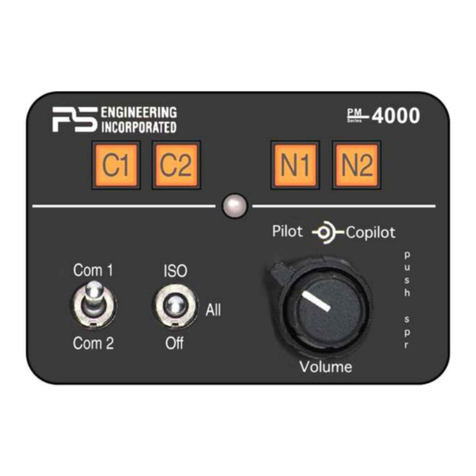
PS Engineering
PS Engineering PMA4000 TSO User manual
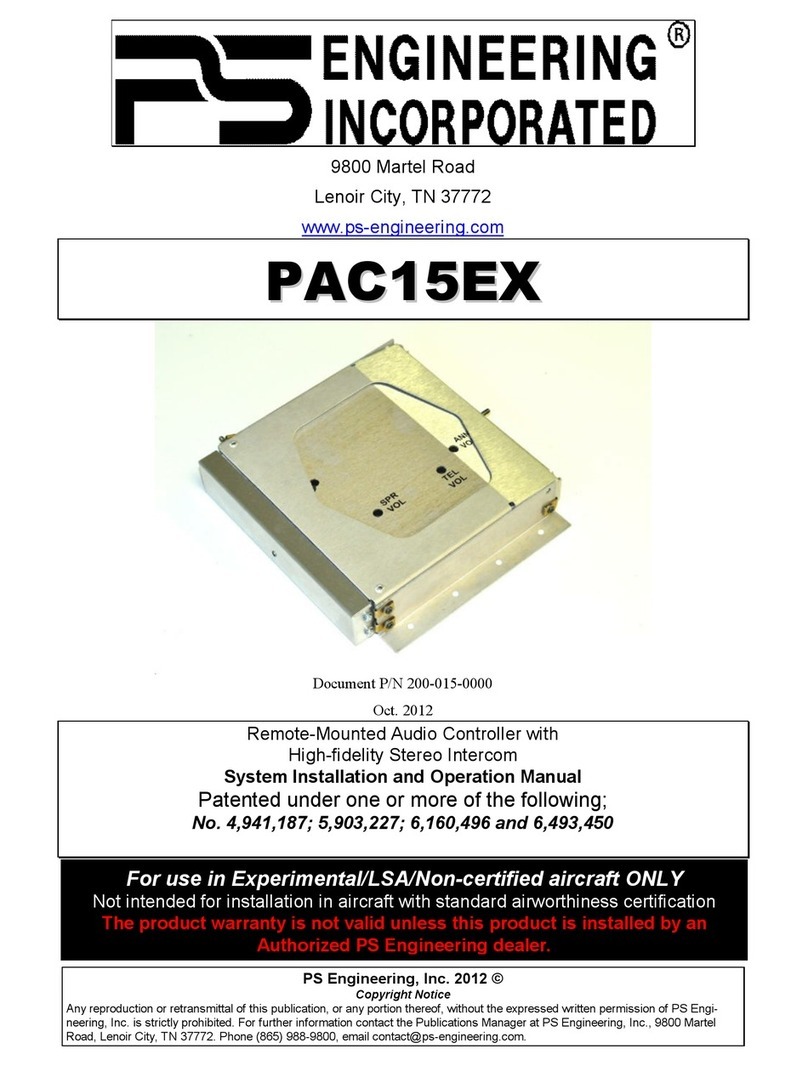
PS Engineering
PS Engineering PAC15EX User guide
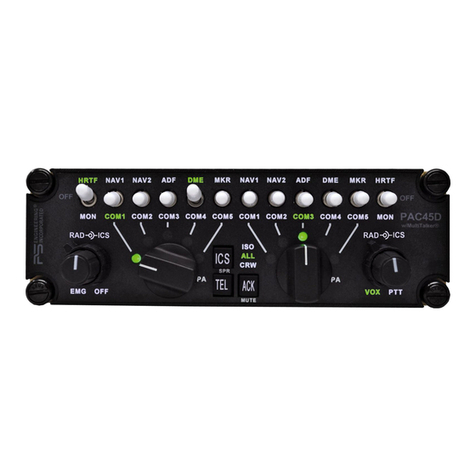
PS Engineering
PS Engineering PAC45D User guide

PS Engineering
PS Engineering PM1200 Manual
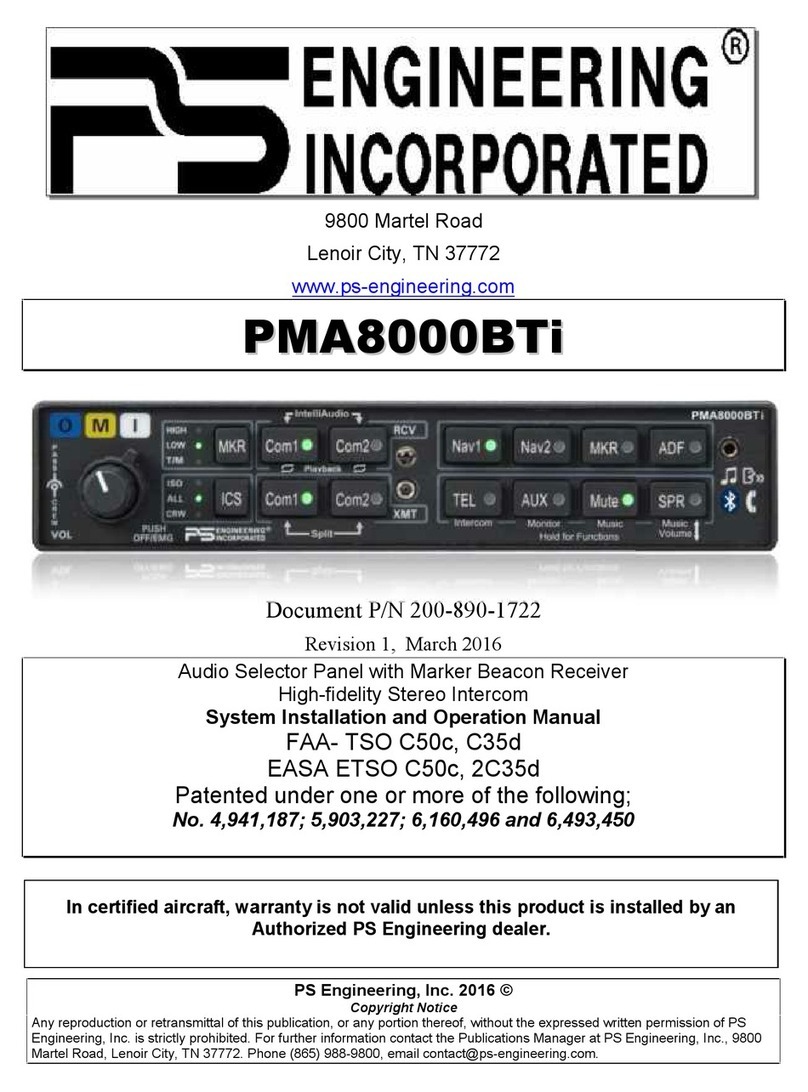
PS Engineering
PS Engineering PMA8000BTi User manual
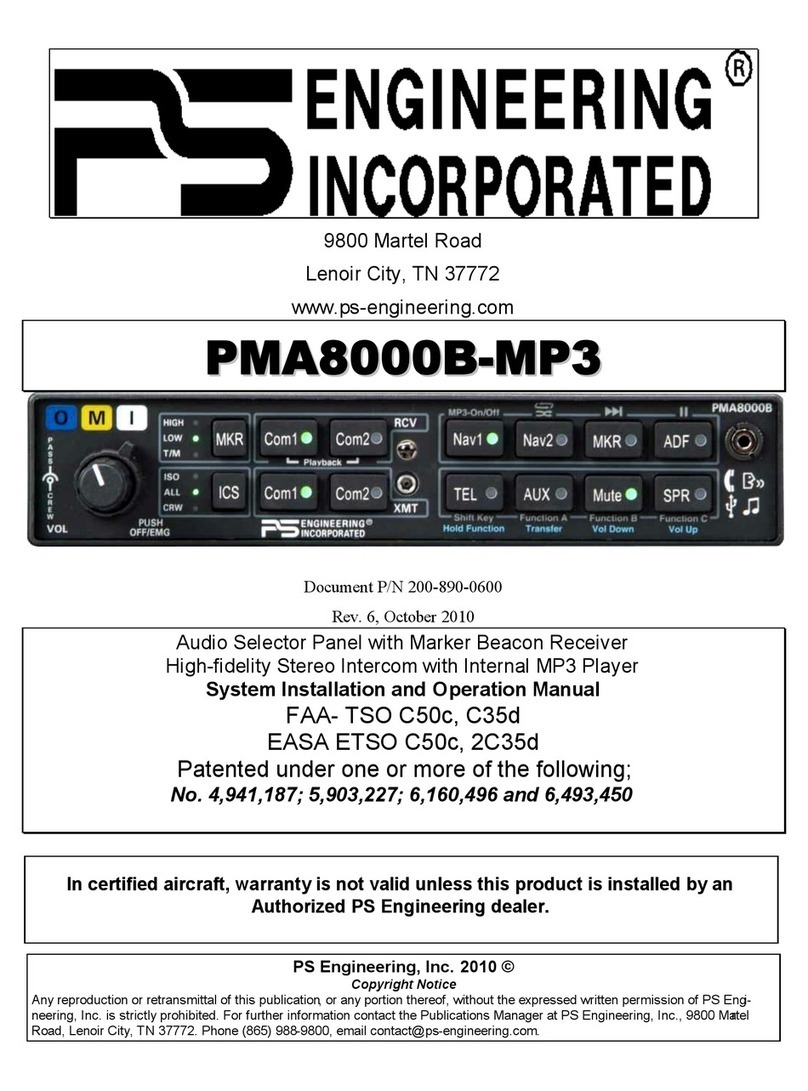
PS Engineering
PS Engineering PMA8000B--MP3 User manual
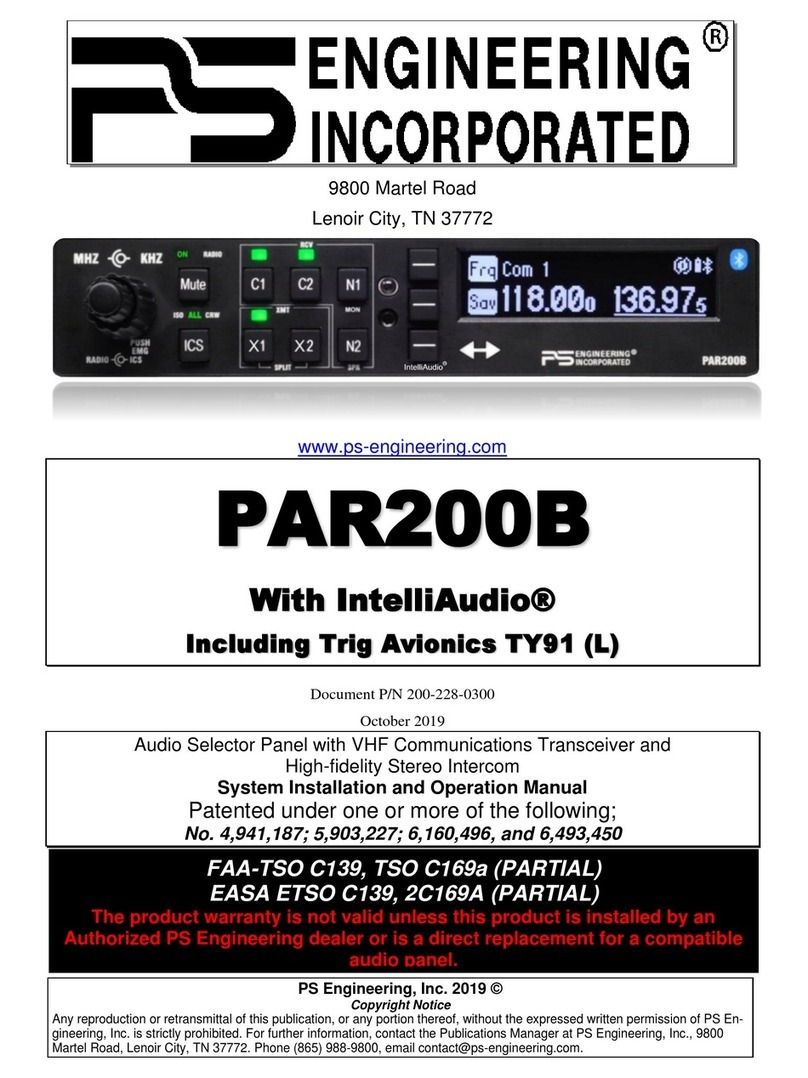
PS Engineering
PS Engineering PAR200B User guide

PS Engineering
PS Engineering PAC45L User manual

PS Engineering
PS Engineering PMA8000G User guide

PS Engineering
PS Engineering PMA8000BTi User manual
